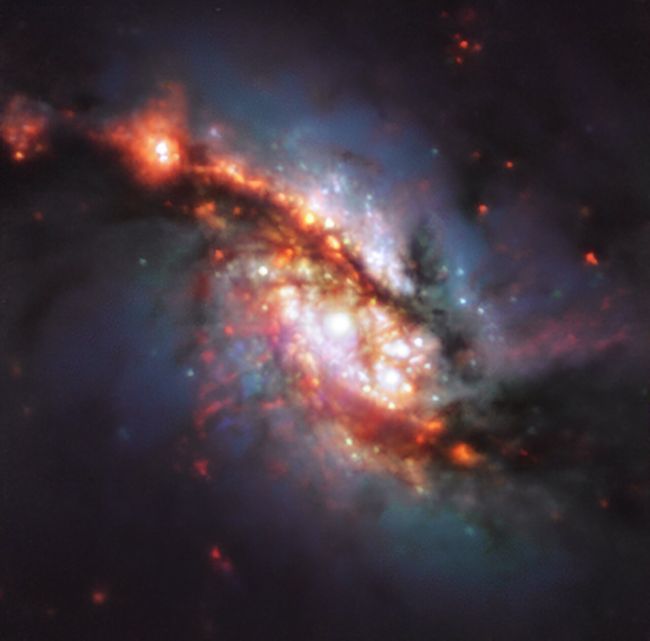
Name this Segment! The Best Space Pics of the Week
Share
Welcome to a new and potentially ongoing blog about featuring the best images of space over the past week.
Not only are we making this digest more digestible... I mean, we are putting them all in one place so it's easy for you to get them all.
But doing it in a weekly segment on the site means that Facebook or Instagram won't compress the images and you'll see them in all their original glory and detail.
If you have a name for this weekly segment of images, please pop it in the comments section or feel free to email us at the contact link here.
And here we go!
3D projection on United Launch Alliance's Delta IV Heavy rocket

(Image credit: United Launch Alliance)
The ULA's Delta Heavy became a 3D backdrop in a showcase for the future of space exploration at Cape Canaveral's Launch Complex-37.
During the projection, a voice-over spoke the words "We are dreamers, inspired by possibilities not yet imagined; believers driven to harness the potential of space; leaders combining expertise and ingenuity — and it all started with a spark of the imagination,"
Its satellite launch was aborted with only 3 seconds remaining on the countdown, however, reschedule is expected any day now.
Cracker pic though.
NASA's Terra Satellite Spots Hurricane Laura

Image credit: NASA EOSDIS/LANCE/GIBS/Worldview/JPSS/Joshua Stevens
NASA's Terra satellite spotted Hurricane Laura with this natural-colour image on AEST Aug. 27, 2020, as the storm neared the Gulf Coast before making landfall early morning on Aug. 28.
About 200 kilometres east of NASA's Johnson Space Center where ISS operations take place.
Check out the scale in the bottom left to get some perspective on the size of this thing...
United Arab Emirates' Hope Mission Catches Mars

Image credit: MBRSC
The star tracker aboard the UAE's Hope Mission snapped this little white dot (that's actually our big brown neighbour) on its first interplanetary mission.
The mission aims to add to the growing body of knowledge about Mars' climate and atmosphere and will arrive sometime in February 2021 and will stay on the planet for about one Mars year (approximately two Earth years).
LightSail 2 Spots Hurricane Laura

Image credit: The Planetary Society
The Planetary Society's crowdfunded Lightsail 2 spotted Hurricane Laura near the Caribbean on AEST August 25, 2020. The Hurricane is visible in the lower left of the solar sail.
Lightsail 2 is the second iteration of the Planetary Society's sail designed to test whether a satellite could orbit our planet for a year with only the sun's rays providing power.
So far, so good.
Hubble captures a view of Comet NEOWISE

Image credit: NASA/ESA/A. Pagan (STScI)/Q. Zhang (Caltech)
The "Pie in the Sky" captured the back end of the celebrity comet NEOWISE after it successfully made its way past the sun and on a course for deep space.
These images can lend some understanding about early solar system dust and creation.
NGC 1365 Seen By The VLT

Image credit: ESO/TIMER survey
The Very Large Telescope in Chile spotted NGC 1365 (or the Great Barred Spiral Galaxy) 56 million light-years away in the Fornax galaxy cluster. The rare twin bar structure (the dark bits) is thought to be caused by the simultaneous actions of galaxy rotation and the individual dynamics of its stars.
Hubble Peeps NGC 595

Image credit: NASA, ESA, and M. Durbin, J. Dalcanton, and B. F. Williams (University of Washington)
A gigantic, galactic fluffy patch of pure star stuff. This magnificent nebula is located just three million light-years away in the Triangulum Galaxy.
The colour filter highlights the ionised hydrogen.
Burgundy Hydrogen Gas Streams

Image credit: Hubble image: NASA, ESA, M. Sun (University of Alabama) and W. Cramer and J. Kenney (Yale University); Subaru image: M. Yagi (National Astronomical Observatory of Japan)
This composite image uses combined data from Advanced Camera for Surveys on the Hubble Space Telescope and the Subaru Telescope in Hawaii.
The big burgundy cosmic tail emerging from the spiral galaxy D100 is hydrogen gas emanating from the galaxy's centre and making its way to the centre of the gigantic Coma galaxy cluster.
If you zoom in on the middle of the tail you'll see baby blue clumps of infant stars where there's enough hydrogen gas to fuel star formation.
Cheers for being with us yet again and helping spread Aussie space awareness. If you want to take things a bit deeper, consider flaunting your supporter gear in our Australian Space Society.
#Space_Aus




